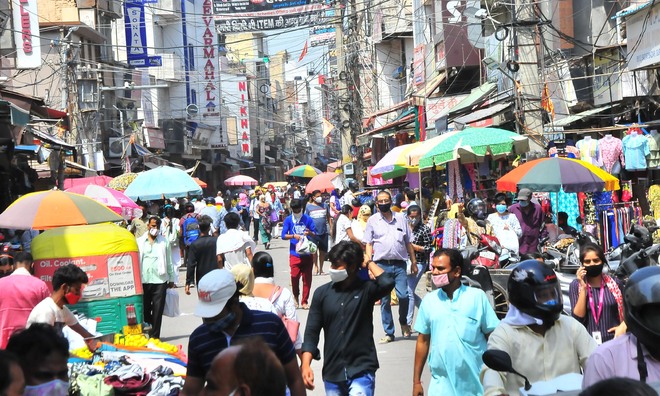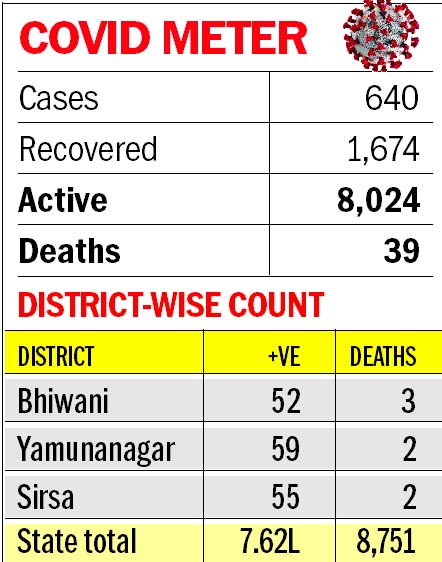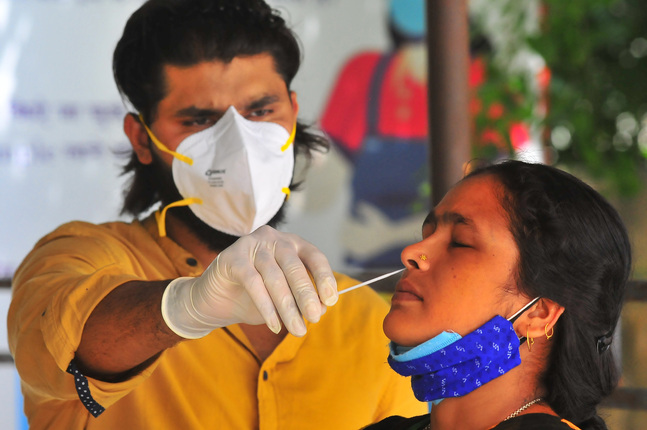
Gurugram district has the highest cumulative positivity rate of 11.59% in Haryana.
Sushil Manav
Tribune News Service
Chandigarh, June 7
Sixteen of 22 districts of Haryana are still in the red zone with their cumulative positivity rate more than 6 per cent even as at 6,902, the weekly cases of Covid have dipped to an 11-week low.
- Also read: In May, Hisar witnessed 3-time jump in fatalities
- Metro train services resume in Bahadurgarh at 50% capacity
- Rohtak traders violate odd-even orders

Deaths coming down gradually
Deaths generally start coming down two weeks after the peak of a wave. This time, people died of black fungus too. Daily Covid deaths are gradually tapering off and we hope that the number will drop further in next 2 or 3 days.

At 491 deaths in the past seven days, the mortality rate is disproportionate to the new infections in the state. A positivity rate above 6 per cent is categorised as critical one while the desirable rate as per the ICMR norms is less than 2 per cent.
With 11.59 per cent, Gurugram has the highest positivity rate among all districts of the state, followed by Faridabad with 11.55 per cent, Panipat 10.11 per cent, Hisar 9.49 per cent, Panchkula 8.86 per cent, Fatehabad 8.51 per cent and Sonepat 8.50 per cent.
 Karnal district has cumulative positivity rate of 8.36 per cent, Mahendragrah has 8.33 per cent, Jind 8.23 per cent, Sirsa 7.60 per cent, Bhiwani 7.38 per cent, Yamunanagar 7.37 per cent, Rewari 7.33 per cent, Ambala 7.20 per cent and Kurukshetra 6.03 per cent.
Karnal district has cumulative positivity rate of 8.36 per cent, Mahendragrah has 8.33 per cent, Jind 8.23 per cent, Sirsa 7.60 per cent, Bhiwani 7.38 per cent, Yamunanagar 7.37 per cent, Rewari 7.33 per cent, Ambala 7.20 per cent and Kurukshetra 6.03 per cent.
Nuh is the only district to have a desirable positivity rate of 1.82 per cent and is placed in the green zone while five other districts are in the orange zone with positivity rate higher than 2 per cent and lower than 6 per cent.
With 5.81 per cent, Rohtak has the highest positivity rate among districts in the orange zone followed by Palwal 4.55 per cent, Kaithal 4.28 per cent, Jhajjar 3.98 per cent and Charkhi Dadri 3.69 per cent.

Gurugram is the only district of the state to have tested more samples than its total population i.e. 1,02,723 samples per lakh population. The closest district with second highest tests per lakh population is Panchkula with 61,010 tests while with 18,962 tests per lakh population, Jind district is at the bottom. Explaining the higher number of tests than the district’s population, Dr Virender Yadav, Civil Surgeon, Gurugram, said at first, the population of 2011 Census was being considered for all purposes and then there were a large number of persons living here for their jobs, who were actually registered as residents of other districts or states.
Meanwhile, explaining the reason behind mortalities being disproportionate to the new infections, Rajeev Arora, Additional Chief Secretary, Health and Family Welfare, said deaths generally start coming down two weeks after the peak of a wave.
He said this time, there were mortalities due to black fungus as well. “Daily deaths are gradually tapering off and there is a decline in the number of mortalities each passing day. We hope that the daily deaths will also come down further in the coming 2 or 3 days,” Arora added.
Join Whatsapp Channel of The Tribune for latest updates.



























